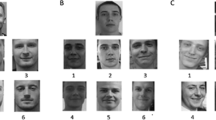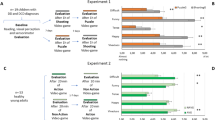Abstract
The present study compared the performance on apraxia tests and additional motor tasks between medicated chronic schizophrenic inpatients (n=21) and healthy subjects (n=21). Praxis testing did not reveal a clear-cut apractic syndrome in the patient group. The most striking difference between patients and healthy controls was the more frequent use of body parts as object (BPO) by schizophrenic patients (P<0.0003). There was no significant difference in psychopathology between subgroups classified according to their BPO performance, although a tendency towards a difference in duration of illness and the actual hospitalization period existed between BPO subgroups. Schizophrenic patients performed more poorly than controls in frontal motor tasks: sequencing, including oral sequential movements, and reciprocal innervation. Frontal motor task performance tended to be related to the negative dimension of schizophrenia in accordance with previous studies. The data do not support the assumption that BPO performance is part of a multidimensional concrete attitude in schizophrenic patients. Nevertheless, this peculiarity in motor behaviour might be a link between neurophysiology and psychopathological phenomenology in schizophrenia. We therefore suggest further investigation focusing the performance of objectrelated pantomime movements in schizophrenic patients.
Similar content being viewed by others
References
American Psychiatric Association (1987) Diagnostic and statistical manual of mental disorders (DSM-III-R), 3rd edn revised. American Psychiatric Association, Washington, DC
Andreasen NC (1982) Negative symptoms in schizophrenia. Definition and reliability. Arch Gen Psychiatry 39:784–788
Andreasen NC (1989) Neural mechanisms of negative symptoms. Br J Psychiatry 155 (Suppl 7):93–98
Bleuler E (1911) Dementia praecox oder Gruppe der Schizophrenien. In: Aschaffenburg G (ed) Handbuch der Psychiatric, spez. Teil 4/I, Deuticke, Leipzig, pp 132–178
DeJong R (1967) The neurological examination. Harper & Row, New York
Duffy RJ, Duffy JR (1989) An investigation of body part as object (BPO) responses in normal and brain-damaged adults. Brain Cogn 10:220–236
Fahn S, Elton RL (1987) Unified Parkinson's Disease Rating Scale. In: Fahn S, Marsden CD, Calne DB, Goldstein M (eds) Recent developments in Parkinson's disease (vol 2) Macmillan health care information, Florham Park, New Jersey, pp 153–163
Freeman T (1969) Psychopathology of the psychoses. Tavistock Publications, London
Frith CD, Done DJ (1988) Towards a neuropsychology of schizophrenia. Br J Psychiatry 153:437–443
Geschwind N (1975) The apraxias: neural mechanisms of disorders of learned movement. Am Sci 63:188–195
Goldstein K, Scheerer M (1941) Abstract and concrete behavior. Psychol Med Monogr Suppl 53:239
Goodglass H, Kaplan E (1963) Disturbance of gesture and pantomime in aphasia. Brain 86:703–720
Goodglass H, Kaplan E (1983) The assessment of aphasia and related disorders. Lea & Febiger, Philadelphia
Gray JA, Feldon J, Rawlins JNP, Hemsley DR, Smith AD (1991) The neuropsychology of schizophrenia. Behav Brain Sci 14:1–84
Günther W, Günther R, Eich FX, Eben E (1986) Psychomotor disturbances in psychiatric patients as a possible basis for new attempts at differential diagnosis and therapy. Eur Arch Psychiatry Neurol Sci 235:301–308
Hécaen H (1981) Apraxias. In: Filskov SB, Boll TJ (eds) Handbook of clinical neuropsychology. Wiley, New York, pp 257–286
Heilman KM (1979) Apraxia. In: Heilmann KM, Valenstein E (eds) Clinical neuropsychology, Oxford University Press, pp 159–185
Kay SR, Fiszbein A, Opler LA (1987) The positive and negative syndrome scale (PANSS) for schizophrenia. Schizophr Bull 13:261–276
Keitesz A, Ferro JM (1984) Lesion size and location in ideomotor apraxia. Brain 107:921–933
King HE (1954) Psychomotor aspects of mental disease. Harvard University Press, Cambridge, Massachusetts
Kleist K (1908) Untersuchungen zur Kenntnis psychomotorischer Bewegungsstörungen bei Geisteskranken. Klinkhardt, Leipzig
Kraepelin E (1904) Psychiatrie: Ein Lehrbuch für Studierende und Ärzte. Barth, Leipzig
Liepmann H (1905) Ueber Störungen des Handelns bei Gehirnkrankheiten. Karger, Berlin
Luria AR (1966) Higher cortical functions in man. Basic Books, New York
Manschreck TC, Maher BA, Rucklos ME, Vereen DR (1982) Disturbed voluntary motor activity in schizophrenic disorder. Psychol Med 12:73–84
Merriam AE, Kay SR, Opler LA, Kushner SF, van Praag HM (1990) Neurological signs and the positive-negative dimension in schizophrenia. Biol Psychiatry 28:181–192
Monrad-Krohn GH, Refsum S (1964) The clinical examination of the nervous system. Lewis, London
Oldfield RC (1971) The assessment and analysis of handedness. The Ebinburgh Inventory. Neuropsychologia 9:97–113
Poeck K, Kerschensteiner M (1975) Analysis of the sequential motor events in oral apraxia. In: Zülch KJ et al. (eds) Cerebral localization. Springer, Berlin Heidelberg New York
Poeck K, Lehmkuhl G, Willmes K (1982) Axial movements in ideomotor apraxia. J Neurol Neurosurg Psychiatry 45:1125–1129
Rothi LJG, Mack L, Verfaellie M, Brown P, Heilman KM (1988) Ideomotor apraxia: error pattern analysis. Aphasiology 2:381–388
Simpson GM, Lee JH, Zoubok B, Gardos G (1979) A rating scale for tardive dyskinesia. Psychopharmacology 64:171–179
Spitzer RL, Endicott J, Robins E (1978) Research diagnostic criteria. Arch Gen Psychiatry 35:773–782
Walker E, Lewine RJ (1990) Prediction of adult-onset schizophrenia from childhood home movies of the patients. Am J Psychiatry 147:1052–1056
Weinberger D (1988) Schizophrenia and the frontal lobe. TINS 11:367–370
Yates AJ (1973) Abnormalities of psychomotor functions. In: Eysenck HJ (ed) Handbook of abnormal psychology. Pitman, London, pp 261–283
Author information
Authors and Affiliations
Rights and permissions
About this article
Cite this article
Martin, P., Tewesmeier, M., Albers, M. et al. Investigation of gestural and pantomime performance in chronic schizophrenic inpatients. Eur Arch Psychiatry Clin Nuerosci 244, 59–64 (1994). https://doi.org/10.1007/BF02193520
Received:
Accepted:
Issue Date:
DOI: https://doi.org/10.1007/BF02193520




